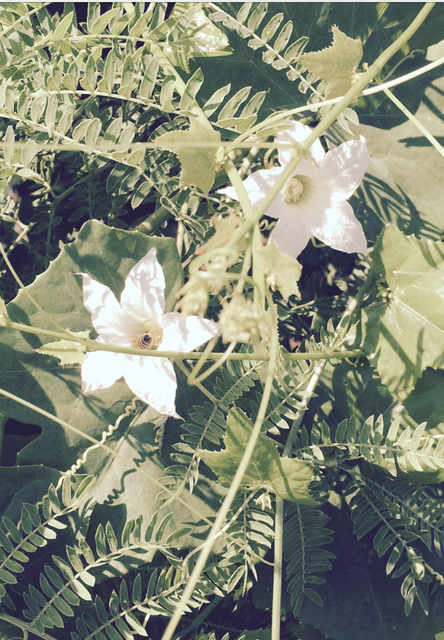Way back in 1995, a mysterious vine began to pop up all over the lowlands of West Hawaii. It also showed up on Oahu about the same time. The University of Hawaii Agricultural Extension offices began to get calls that
Way back in 1995, a mysterious vine began to pop up all over the lowlands of West Hawaii. It also showed up on Oahu about the same time. The University of Hawaii Agricultural Extension offices began to get calls that kudzu vine was sprouting up all over and covering shrubs and trees.
Our offices continued to get phone calls about the kudzu vine that was growing all over the lowland forests around Kailua Village and Windward Oahu. Even though the Outdoor Circle made concerted efforts to educate residents about this vine, there was still considerable misinformation as to what it was and what to do about it.
Since our recent heavy rains, we are again seeing the rapid outbreak of vines along our roadsides and gardens. First of all, this not kudzu. Kudzu is a vigorous legume vine from China that was planted in the southeastern U.S. to control the severe erosion occurring from damaging land practices of an earlier era. Kudzu solved that problem but grew too well.
What we are seeing along our rural roadsides is actually a combination of vine species. Much of it is the ivy gourd, or scientifically named Coccinea grandis. It is a close member of the cucumber. Other vines mixed in with the ivy gourd are several species of morning glory and Desmodium. Desmodium species are a valuable food source for cattle, but when not grazed, the larger growing species can climb into shrubs and trees. As happened 20 years ago, the most rampant growth areas of ivy gourd are beginning to cover koa haole and kiawe along roadsides or where cattle are not grazing. In fact, these plants have been around for years, but grazing pressures and drier weather kept them from becoming a problem. This is much the same case as the banana poka vine that was rampant in some mauka areas of the Big Island and Kauai. When forests are damaged by tropical storms, dormant seeds of vines and other plants have the opportunity to thrive.
Although some folks see the ivy gourd as an ugly alien specie taking over the lowland forests of West Hawaii and Windward Oahu, others see it as nature attempting to heal the wounds made by poor management or changes because of strange climatic extremes. Actually, this plant has been cultivated in India since ancient times, according to Bishop Museum Occasional Papers, Vol. 28, 1988, Nagata. It is used as an ayurvedic drug. It has been used to treat diabetes, dyspnea, cough, emaciation, fever, convulsions, syphilis, gonorrhea, slow pulse, menorrhagia, boils, ringworm, bronchitis, jaundice, anemia and blood disorders. In several Southeast Asia countries, the fruit are eaten raw or cooked. Shoot tips are eaten in stir-fry.
The ivy gourd was probably introduced by immigrants from Asia around the middle of the 20th century because of its benefits, but was not officially collected as a naturalized plant until 1968 around the Punchbowl area. By the mid 1970s, the plant was being popularly cultivated and sold at flea markets as a medicinal plant.
It is obvious that the ivy gourd has become too much of a good thing and that creative management is necessary. The first thing is not to spread it to new areas or other islands. Secondly, remove it from your garden if it is present. Third is to support biological control efforts. Avoid indiscriminate insecticidal applications that might hinder the establishment of bio control insects.
The Department of Agriculture and University of Hawaii researchers looked for biological control. In the 1990s, they found a moth and two weevils that feed on the vine. The DOA evaluated these insects to make sure that they fed only on the ivy gourd. Then there was a general release in areas where the vines were abundant. The advantage to bio control is that it does not totally eradicate a pest species, but brings it down to a level where it is no longer a pest. After the release of these insects, the population of ivy gourd vines gradually diminished until it was rare to see plants. That is until just recently. What happened to the bio control insects? They are undoubtedly still here, but it will take time until the insect populations catch up to the food supply of vines. In the meantime, put on your garden gloves and pull out unwanted vines in your garden.
Remember the ivy gourd fruit and shoot tips are edible, medicinal and good for grazing animals. Even now, pharmaceutical companies canvas Pacific islands for plants of medicinal value and this one has been studied as well. It is clear that by labeling the plant as a virulent vine or alien pest species is to oversimplify. We are learning more and more that we cannot simply label life forms as good guys and bad guys. Nature just is.
It is how we manage that makes the difference. Most lands where ivy gourd has prospered are areas where cattle once grazed and have now grown back to a whole complex of alien species. One management tool is obviously grazing with cattle or other herbivores. Biological control with insects or diseases that feed on the vines is another. In individual gardens, the vine is relatively easy to control by hand weeding before it gets the upper hand. In that event herbicides may be necessary. Or we might just turn the tables on the ivy gourd and use it for food and medicine as older and possibly more mature cultures have done for thousands of years.
This information is supplied as a service of the University of Hawaii College of Tropical Agriculture and Human Resources.



